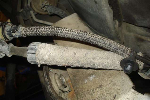97awdx
Well-Known Member
- Joined
- April 3, 2004
- Messages
- 393
- Reaction score
- 3
- City, State
- Lake Wallenpaupack, PA
- Year, Model & Trim Level
- 1998 XLT
For those who want to or have done the BWM. This is taken directly form the Ford Factory Service Manual.
Mechanical Operation
The Borg-Warner 44-11 transfer case is available in the Explorer (A4WD) vehicle. The transfer case transfers power from the transmission to the rear axle, and also to the front axle when electronically activated.
In the Auto mode, torque from the transmission is transferred to the input shaft which, in turn, drives the rear output shaft that drives the rear axle assembly. The electromechanical ball ramp clutch assembly drives the drive sprocket after the 4x4 electronic module activates the clutch coil. The drive sprocket turns the drive chain that rotates the front output shaft and the front driveshaft. In the 4x4 High mode, the operation is the same as in the Auto mode, except that the 4x4 electronic module consistently activates the electromechanical ball ramp clutch assembly.
The high-low shift occurs when the reduction shift fork moves the high-low collar to lock the planetary gear set to the output shaft. Then, torque, transmitted through the sun gear, from the input shaft, turns the front planetary gear set assembly. The front planetary gear set assembly, which is now engaged, provides transfer case speed reduction.
Control-Trac Function
The Control-Trac transfer case uses an electromechanical clutch assembly to control torque to the front wheels. In the Auto mode, while at rest and under cruising conditions, the 4x4 electronic module activates the transfer case clutch at a minimum level. This allows for the slight difference between the front and rear driveshafts which occurs normally when negotiating a corner on dry pavement. Under any of the following conditions, the 4x4 electronic module will increase the torque sent through the clutch to the front wheels in order to prevent or control slip.
Slip is detected (by monitoring the front and rear OSS sensors in the transfer case)
Throttle position (by using the throttle position signal from the PCM)
Mechanical Operation
The Borg-Warner 44-11 transfer case is available in the Explorer (A4WD) vehicle. The transfer case transfers power from the transmission to the rear axle, and also to the front axle when electronically activated.
In the Auto mode, torque from the transmission is transferred to the input shaft which, in turn, drives the rear output shaft that drives the rear axle assembly. The electromechanical ball ramp clutch assembly drives the drive sprocket after the 4x4 electronic module activates the clutch coil. The drive sprocket turns the drive chain that rotates the front output shaft and the front driveshaft. In the 4x4 High mode, the operation is the same as in the Auto mode, except that the 4x4 electronic module consistently activates the electromechanical ball ramp clutch assembly.
The high-low shift occurs when the reduction shift fork moves the high-low collar to lock the planetary gear set to the output shaft. Then, torque, transmitted through the sun gear, from the input shaft, turns the front planetary gear set assembly. The front planetary gear set assembly, which is now engaged, provides transfer case speed reduction.
Control-Trac Function
The Control-Trac transfer case uses an electromechanical clutch assembly to control torque to the front wheels. In the Auto mode, while at rest and under cruising conditions, the 4x4 electronic module activates the transfer case clutch at a minimum level. This allows for the slight difference between the front and rear driveshafts which occurs normally when negotiating a corner on dry pavement. Under any of the following conditions, the 4x4 electronic module will increase the torque sent through the clutch to the front wheels in order to prevent or control slip.
Slip is detected (by monitoring the front and rear OSS sensors in the transfer case)
Throttle position (by using the throttle position signal from the PCM)










